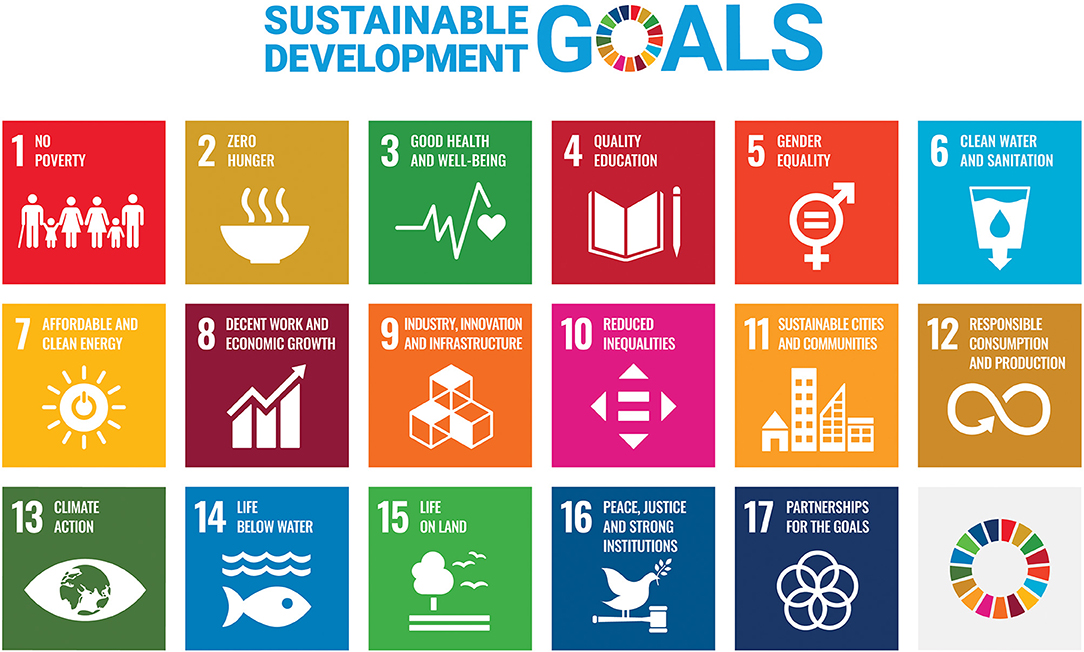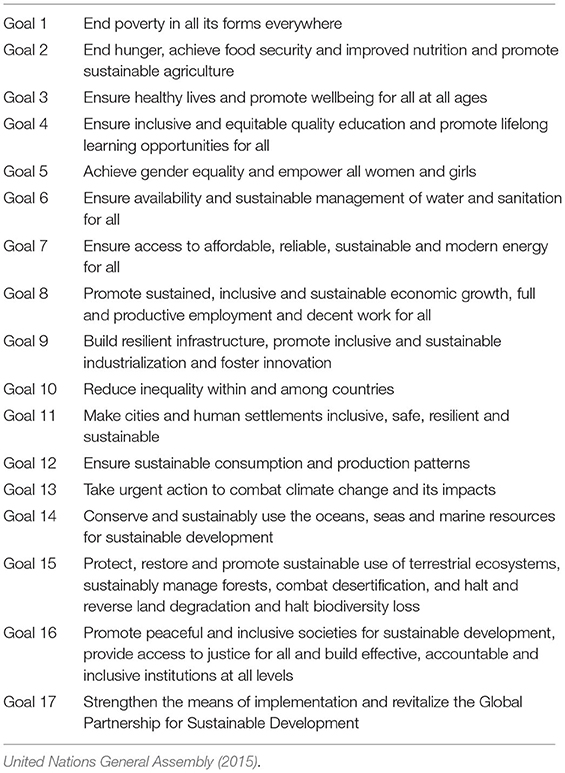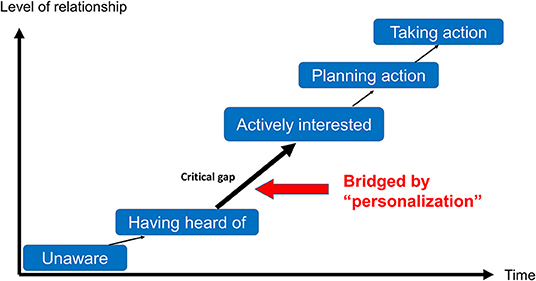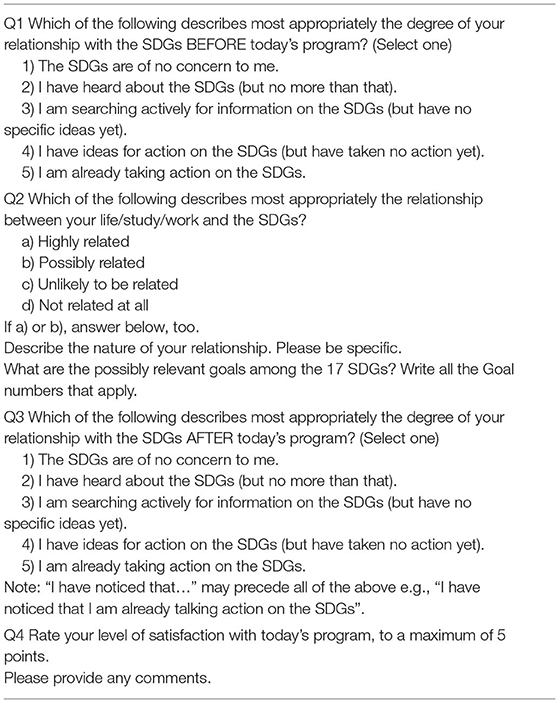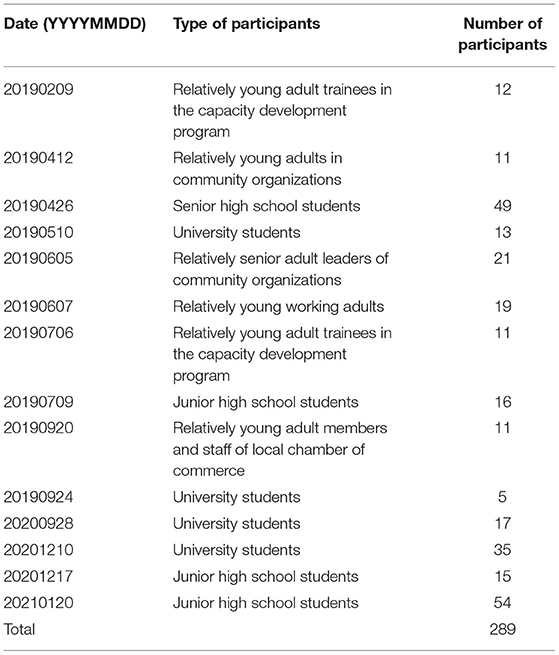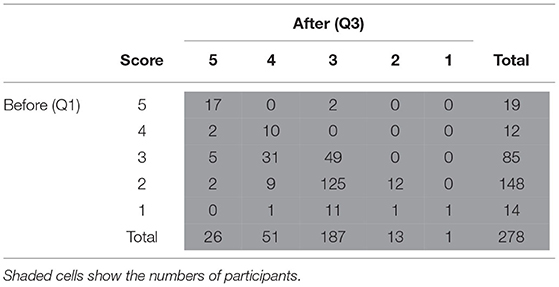- 1Noto SDGs Laboratory, Suzu, Japan
- 2Noto Satoyama Satoumi SDGs Research Program, Kanazawa University, Suzu, Japan
- 3Faculty of International Studies, Otemon Gakuin University, Ibaraki, Japan
- 4Center for Collaborative Study With Community, Gifu University, Gifu, Japan
Sustainable Development Goals (SDGs) require transformations at all levels, from global to local, to be realized. Underlying all of these levels is the personal level, where any transformation begins. Before individual persons change their behavior for sustainability, they will need to not only understand the SDGs, but also regard them as a matter which directly concerns them. A process involving “personalizing the SDGs” needs to exist between initial awareness and subsequent action. However, identifying and instituting the means by which this can be realized is not easy. In this study, we designed a learning program that combined an existing SDGs game with an original self-reflective questionnaire, and implemented it in Ishikawa Prefecture, Japan. The program allowed participants (n = 289) to first play the game, which takes the form of a simulation of the world in the run up to 2030, and then carry out individual and/or group work to consider their individual, specific relationships with the global agenda. The questionnaire also provided each participant with a means to reflect on their initial perceptions and how they changed following this learning. The answers on the questionnaire indicated that the program aided the participants in raising their perceived levels of relationships with, and the personal significance of, the SDGs, while having fun at the same time. Personal relationships with the SDGs were expressed more concretely when local contexts and topics covered in other learning programs were tied in with the SDGs.
Introduction
Sustainable Development Goals (SDGs) are a comprehensive set of global agendas requiring transformations at all levels to be realized (United Nations General Assembly, 2015, Figure 1, Table 1), including specific units of national and local government, as well as in civil society generally. For local-level transformations to occur, it is necessary for local governments and community members to translate their significance into local contexts, and then apply them for community development (Kioupi and Voulvoulis, 2019; Takagi, 2020). Scholars and practitioners of Education for Sustainable Development (ESD) have made practical attempts to localize the sustainability agenda (Pesanayi and Lupele, 2018).
Underlying all the aforementioned levels is the personal level, because all transformations begin at the level of individual human beings. Before an individual instigates changes in their behavior aimed at accommodating the SDGs, they will need to not only understand the SDGs, but additionally regard them as a matter which directly concerns them. As such, a process involving “personalizing the SDGs” needs to exist between initial awareness and subsequent action.
However, even while recognizing the necessity for this process, the issues of identifying and then instituting the means to realize the process must be addressed. Another issue is the difficulty of measuring learning outcomes. Development of methods to monitor and evaluate the outcomes of transformative learning for sustainability is an ongoing task of researchers and practitioners (Okitsu, 2019).
To tackle the above two issues, we set two research questions: (1) What is an effective learning program to support personalization of the SDGs? (2) What is a method of evaluation in terms of learning outcomes, that is, the degree to which SDGs are personalized?
We decided to implement this research on the ground, in light of the need and expectations regarding an introductory learning program at local schools, universities and community organizations. The participation of active learners is considered key to the process both of finding individual and collective meaning in pursuing the SDGs (Kioupi and Voulvoulis, 2019).
This paper reports on the learning program that we designed and implemented, making use of a game and self-reflective questionnaire combined. The program allows participants to first play the game in the form of a simulated world in the run up to 2030, followed by individual and/or group work to consider their individual, specific relationships with the global agenda. The following describes the conceptual framework, as well as the game and questionnaire as the concrete means used in the program. Later sections summarize the results of our implementation and discuss the findings, including the constraints and limitations.
Pedagogical Framework
Conceptual Framework
Participatory learning incorporating experiences and reflection can influence learner perceptions, which may lead to behavioral change (Mezirow, 2008; Chiba et al., 2021). Problem-posing dialogue, as theorized by Paulo Freire, is an approach used in such types of learning (Nixon-Ponder, 1995), with this approach enhanced by instructional design theories including the ARCS (attention, relevance, confidence and satisfaction) model used to specify the important steps (Keller, 1987). Likewise, the learner's commitment to the SDGs increases over a progression of steps (Takagi, 2020), and we placed particular emphasis on the processes of personalization aiming to bridge the critical divide between the levels of vague awareness of, and active interest in, the SDGs (Figure 2). By “personalization,” we mean an individual's understanding of their relationship with a certain subject matter, in this case the SDGs.
It is worth explaining why we focused on the divide between vague awareness and active interest. On the one hand, a large number of people in Japan had never heard about the SDGs by early 2019, when we were designing this study (World Economic Forum, 2019). At the same time, however, there was very wide and frequent coverage of the SDGs in mass media, owing to which we were certain that awareness levels would rise soon and rapidly. On the other hand, we had the impression that those who had already been initiating their own SDGs-related actions were quick to realize what the SDGs meant to them. We reasoned that assisting this process of personalization for a wider range of people would be a next and important task. Our assumption was that once people gain personally-adapted perceptions of the SDGs, they would be more likely to start searching actively for information relevant to their own work or life, even without much assistance. People at this stage would be able to plan their action relatively easily. This assumption prompted us to focus on the gap between vague awareness and active interest.
We then specified four principles in our program design. First, it should be based on active learning, rather than one-way teaching. Second, our program should be able to function as both a relatively short and one-time event, as the demand exists for such an introductory program. Third, the program should include a process of self-evaluation, in which learners can reflect on their own perceptional change and write it down right away. This is assumed to enhance learning outcomes, and also provides evidence when assessing the effectiveness of the program. Lastly, but essentially, is the principle that the program be premised on being enjoyable, to allow learners to maintain their engagement and motivation throughout the program.
The above-mentioned principles assume that different modes of learning, i.e., engagement, imagination, and alignment, help learners identify their positions in relation to the issue in question (Wenger, 2010). In concrete terms, personalization of the SDGs is ideally prompted by engaging all three domains of: the head (cognitive domain), the hands (psychomotor domain), and the heart (affective domain), as suggested by Kioupi and Voulvoulis (2019). We also take into consideration the importance of facilitating the processes, whereby participants search for their own answers rather than the instructors suggesting or providing answers.
In designing our program, however, the limited time available for each session was a challenge. Requests from schools and local organizations tended to be for a one-time session of 1 or 2-h duration only. To allow us to satisfy the principles mentioned above and ensure that we could incorporate both experiential and reflective processes, we decided to design a program of a minimum 90-min length. A 90-min program, which might not ordinarily be deemed sufficient in terms of the time required to prompt significant changes in real-life behavior, seemed to be a realistic compromise. This is because a program of this length could nevertheless facilitate a small, though important, first step to exploring different decisions and potential behaviors.
In terms of the tools, we arrived at the idea of combining an interactive card game and a self-reflective questionnaire. Games are increasingly used to learn about complex issues and ultimately transform behavior (Den Haan and van der Voort, 2018; Koivisto and Hamari, 2019). A rapidly increasing number of peer-reviewed academic papers have been published in the last several years on the use of games in sustainability learning, demonstrating their effectiveness (Stanitsas et al., 2019). One stream of such research defines its purpose as motivating participants to consider and possibly change their behaviors (Kumazawa, 2021). This purpose follows an assumption that the process of undergoing behavioral change in a simulated world can potentially bridge the divide between knowledge and action (Fernández Galeote et al., 2021), supporting changes in decisions and collaboration for sustainable development (Meinzen-Dick et al., 2018). Game playing also enables learners to anticipate diverse paths toward a sustainable future, a practice particularly important in times of complexity and uncertainty (van Der Leeuw, 2020; Vervoort et al., 2022).
Experiential learning can be deepened by incorporating a reflection process to allow participants to better understand the systems underlying the issues in practical terms (Craps and Brugnach, 2021), and interrogate the significance of their own learning experience by means of expressing it in words (Mezirow, 1990). Learner self-assessment can also be used to measure learning outcomes (Takahashi and Hoffmann, 2019). We therefore decided to use a one-page questionnaire that would function as a comparatively quick and easy tool for self-reflection and assessment.
Card Game
We used a card game called “2030 SDGs,” developed in 2016 by an organization named Imacocollabo. The game was initially made in Japanese, which is the version we used in this study. It was later translated into other languages, including English. This is a game playable by between 5 to 20 teams, each of which consists of one or more persons. It requires a trained facilitator to design and oversee a program, which will typically involve an introduction, game playing, reflection, and in some cases a follow-up lecture. The facilitator first briefly introduces participants to key facts regarding the SDGs, followed by an overview of the rules of the game. During the game, players try to fulfill the respective personal goals assigned to them, i.e., wealth, a leisurely life, poverty alleviation, environmental protection, and social equity, in a simulated world leading toward 2030 (for details of the game, see Imacocollabo, n.d.).
Players use a finite amount of their resources, i.e., time and money, to carry out projects, such as constructing transportation infrastructure, promoting green consumption, and reforming medical systems. Each project has different impacts on the players' resources, as well as conditions in the simulated world, in the three domains of economy, environment, and society. A typical setting is for four participants to share a table, with several tables arranged like islands in a room. However, this will be dependent on the resources and constraints at each venue. During the playing time of the game, participants can move around. Just as in the real world, players can exchange information and negotiate with each other. They can also, by mutual agreement, relinquish or exchange any of the resource cards, such as those for time, money, or incomplete projects (Figure 3).
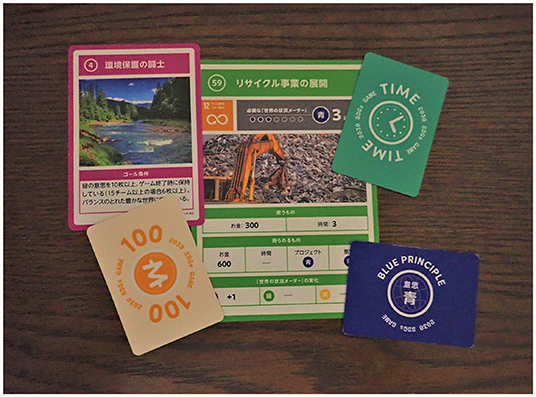
Figure 3. Samples of the cards used in the game “2030 SDGs” (Source: Own photo, with permission by Imacocollabo).
At the end of the playing time, participants share the results regarding who and how many among them have achieved their personal goals, as well as those on the conditions in the simulated world of 2030. The essence of the game is to understand that any action taken by any person at any time has impacts, desirable or otherwise, on the entire world. Players must also consider the nature of desirable conditions in the simulated world in the process of pursuing their personal goals.
The game developer specifies that 2030 SDGs be played only under the guidance of a certified facilitator who has completed a paid, 3-day training course and passed an examination. The first author of this paper became a certified facilitator in March 2019, and has since used the game in our learning program on a not-for-profit basis.
The game 2030 SDGs has been used widely at schools and organizations (e.g., Mada et al., 2020), although its usefulness for improving learning outcomes has not been measured systematically. We found no published academic paper assessing its usefulness in peer-reviewed journals. We considered it meaningful to present this assessment as an example, which would be of some use to those planning or implementing similar learning programs using the same or a different game.
Self-Reflective Questionnaire
The questionnaire aims to provide each participant with a means to reflect on their initial perceptions and how they changed following this learning. We included four key questions in our original questionnaire (Table 2).
The first key question (Q1) is about the level of relationship between the participant themselves and the SDGs, to be answered before starting the program. The other three key questions are answered after the game experience. Q2 asks about the relationship between the participant and the SDGs in more detail than Q1, while Q3 is fundamentally the same as Q1, but answered after they have gone through the learning program. The paired answers enable pre- and post-learning comparisons.
It is worth noting that we made minor adjustments to the wording in Q2, depending on the participant group on each occasion. For example, junior high school students, with an age range of between 12 and 15, were asked about the relationship between their “life” in general and the SDGs, while adult professionals were asked about their “activities,” indicating their work and voluntary roles in the local community. Despite this adjustment, however, we intended to facilitate basically common processes, in which participants could explore their own attitudes, as well as any (potential) change in these attitudes, when considering from SDG perspectives.
Learning Environment
Our study site is Ishikawa Prefecture, Japan, focused largely in Suzu, a rural city located at the far end of Noto Peninsula. Noto is famous for its rich “satoyama and satoumi,” which are the Japanese terms meaning social-ecological production landscapes and seascapes (Duraiappah et al., 2012).
Kanazawa University has collaborated with the municipal government of Suzu since the establishment of the Noto School in 2006. The school houses a small team of researchers to conduct community-based research and capacity development (Nakamura and Kitamura, 2018; Kitamura et al., 2020; Kikuchi et al., 2021). These activities led to the designation of Suzu by the Japanese Government as one of the first SDGs Future Cities in 2018, with the establishment of a new platform for multi-stakeholder collaboration, the Noto SDGs Laboratory (Kitamura et al., 2021).
When undertaking this study, both authors of this paper were researchers based in the Noto School, affiliated with Kanazawa University and Noto SDGs Laboratory, with the mission of providing local people in Suzu, as well as students of Kanazawa University, with learning opportunities on the SDGs. During the 2 years from February 2019 through January 2021, we implemented our learning program on 14 occasions with various groups from civil society, comprised of high school students through to young professionals active in community development, as well as senior leaders in the local communities, and largely at the request of these host organizations (Table 3). Our program implementation was based on these requests from host organizations, resulting naturally in a diversity of participants.
Results
Change of Perceived Relationships With the SDGs
A total of 289 participants completed the program with their questionnaire filled in over the 14 occasions we implemented the program. As mentioned earlier, our program implementation was based on the requests from the host schools and organizations. The participants were accordingly diverse, ranging from junior high school students to senior citizens in community organizations. The sample numbers were not large enough to represent any group of people in society. We present the following results as those in this preliminary study within this limited scope.
In terms of the comparison between the scores in Q1 and Q3, 278 participants answered both questions, providing usable data for the before/after comparison (Table 4). The average scores in Q1 and Q3 were 2.55 and 3.32, respectively, meaning an increase of 0.77 when comparing the before/after average scores. We also applied the Wilcoxon signed-rank text against the paired datasets, which revealed a significant difference (p < 0.05), suggesting an increase of the representative values when comparing the scores in Q3 with Q1.
One hundred and eighty-seven (187) participants (67.3%) showed an increase, i.e., a higher score in Q3 than Q1. Eighty-nine (89) participants (32.0%) had the same scores in the two questions, i.e., no change. Two (2) participants (0.7%) showed a decrease in their scores. Both of these latter scored 5 before, and 3 after the learning program.
The most representative answer (148 participants) in Q1 was the score of 2, accounting for 53.3% of all scores. Out of these 148 participants, 136 participants showed an increase in score when answering Q3, meaning they scored either 5, 4 or 3 in Q3. Among them, a majority (n = 125) scored 3 in Q3. This combination of the before/after scores (from 2 to 3) was the highest ratio (45.0%) of all the participants. Twelve (12) participants had no change in their before/after scores (from 2 to 2). No participant had a decrease from 2 to 1.
Description of the Relationships With the SDGs
As Q2 was an open-ended question, participants used it to express their specific relationships with the SDGs in various ways. Q2 also asked about the specific goal number(s) among the SDGs that would apply to their relationships. We added this optional sub-question from the second time we implemented the program.
The results showed several trends. SDG 14 (Life below Water) was mentioned by the highest number of participants (n = 103), followed by SDG 15 (Life on Land, n = 89). This trend was evident with groups studying satoyama and satoumi as their general theme. At the program implemented with the administrators of public halls, responsible mainly for senior citizens' activities in their communities, SDG 3 (Good Health and Wellbeing) attracted the highest number of votes, i.e., 10 out of 21 participants. At the program implemented with the Chamber of Commerce members and secretariat staff, SDG 8 (Decent Work and Economic Growth) had the highest number of votes, i.e., 5 out of 11 participants. As such, there was a relationship between the goal numbers and the missions of respective groups.
Participant comments added context to their answers, as shown in the below examples. An adult participant (Participant code: A-001) of the capacity development program in Noto commented: “Through my handicrafts using threads dyed with natural colors extracted from Noto's satoyama and satoumi, I am trying to make people more interested in, and appreciative of, the richness of nature in Noto. Therefore, my activities seem to connect best with SDGs 14 and 15.” Other participants with livelihoods involving satoyama, such as a professional hunter (B-003), who was concerned with achieving a mutually beneficial balance between animals and humans, and a charcoal producer (B-002) involved in planting and cultivating forests, also pinpointed a deep connection with SDG 15.
A high school student (H-011) studying marine environmental issues mentioned her own action of joining a volunteer beach-cleaning group, with SDG 14 specified as her most relevant goal. A business owner (F-004) commented that: “Corporate activities are not just for 1 year but must develop perpetually, and therefore it is my priority goal to create an enterprise where employees feel motivated and convinced of the value of their work (SDG 8).” An adult participant also spoke up to comment during the post-game discussion that he had just learned that the activities he had been doing could feed in to the SDGs.
Level of Satisfaction With the Program
With respect to the level of satisfaction with the program (Q4), 279 participants provided scores, with 5 set as the maximum. The average score overall was 4.54. The average scores were >4 points on each of all 14 occasions the program was implemented. A total of 170 participants (60.9%) gave the maximum score of 5. Many participants commented that the program was an opportunity to learn in an enjoyable manner.
Other Observations
Other observations of the facilitator also merit mention and are noteworthy from the following perspectives. A first perspective is that of communication and cooperation. Results of the card game varied greatly, informed largely by the quantity and quality of communication and cooperation among the participants. We observed instances of active communication and cooperation that clearly contributed to achievements of personal goals within the game, as well as balanced conditions in the simulated world. We also observed instances of the opposite, whereby only a little more cooperation would likely have yielded considerably more desirable results.
Several participants expressed regrets that there could have been better communication and cooperation to better serve conditions in the simulated world, as well as the outcomes of individual goals. A high school student (P-002) expressed this matter precisely: “Through the card game experience, I understood that the global goals can only be achieved through the cooperation of everyone in the simulated world. I also understood that a change in one thing can influence the whole, prompting me to think that I wish to act in such a way as to bring about positive influences, however trivial.” This is one example of the valuable lessons learned from participant experiences.
A second perspective is the physical set-up of the venues. On the first occasion of program implementation, the room was relatively packed, and the layout was not conducive to the free movement of participants. We learned after the game that the participants in one corner weren't exchanging information with those in the far corner, depriving them of opportunities to facilitate their goals through cooperation.
The influence of the layout on outcomes is a reminder that rural communities in real world locations distant from cities are disadvantaged by both their physical remoteness and their lack of access to technologies, limiting self-development opportunities. This in itself is a valuable lesson. On all the subsequent occasions of the program, however, we endeavored to ensure as few physical impediments to communication as possible in such a way that the will and action for participant communication alone would dictate the levels of communication and cooperation present.
A third perspective is the diversity in the ways in which self-reflection occurs. The following are just three remarkable examples. One participant, a high school student, weighed up his influence on the simulated world after the game, with no guidance from the facilitator. During the free discussion, he raised his hand and said: “My goal was wealth, which I achieved at an early stage. Then I tried to improve the environment of the world. I carried out nine projects in total. Unfortunately, the net score of these nine projects was zero for the environment. My projects did however contribute to improvements in the social conditions of the world equivalent to two points. Other than that, I helped other players, who were set on projects that would have positive impacts on the environment and society.” This example, whereby the participant spontaneously reflected on his behavior in a simulated world in terms of its potential to lead to action in the real world, unprompted or guided by the facilitator, is distinctly impressive.
The second example was a university student who after the game said that his goal of seeking an inclusive society was not even near to achievement, which led him to consider stealing the cards (assets) of other participants. This situation can be characterized as paralleling real-world situations involving social unrest. While he didn't go through with this, his “lived” experience of inequality was a source of insightful learning. It was also meaningful that he shared his learning with his peers in the classroom, facilitating a collective learning.
The third example is a written comment by another university student (M-007): “I feel the philosophy of the SDGs is wonderful. At the same time, however, I feel a kind of fear that if everyone in our society regards this philosophy as beyond question, with no room for doubt, they will use this as a source of reproof toward persons with whom they are at variance over these issues.”
While these three are isolated examples, they illustrate the potential for a wide variety of modes of self-reflection, and that excessive guidance may limit the freedom of participants to engage in processes of self-reflection which can lead to insightful learning and creativity.
Discussion
While our main findings will conclude the paper, this section discusses constraints and limitations that we encountered in the course of our research. This was a somewhat preliminary study, with only small numbers of samples from different groups of people, limiting the extent to which its results can be generalized. We also acknowledge the limitations, in addition to the advantages, of subjective evaluation by the participants themselves. It should also be noted that, while this study was designed to facilitate before-and-after comparisons, other approaches, including with-and-without comparisons by setting control groups, have the potential to yield more robust evidence. There is potential merit in sequential studies on a much broader scale, as well as meta analyses in comparative manners, to allow testing or establishing generally applicable theories.
It is not realistic to expect momentous outcomes from short, one-time events. We were well-aware of this constraint before we implemented the program. After implementation, we confirmed that more in-depth learning should be realized only by combining other learning contents at host schools and organizations. It should be kept in mind that an introductory program like the one reported in this paper can only serve as a first, though important, step in sustainability learning.
Similarly, it is not easy to assess the extent to which subsequent action will be taken by participants. Such assessments will require long-term collaboration with the schools and organizations where the learning program is carried out. Arrangements could potentially be made to use the self-reflective questionnaire over a longer term to monitor participants' actual behaviors, particular at schools where such follow-up would be relatively easy.
There is no standard format that works in the context of all potential variations in setting. This study was able to establish one kind of basic format as a learning program on the SDGs. Learning programs invariably require flexibility, as well as customization, on a case-by-case basis dictated by particular preconditions.
All of the above feed in to the necessity for close collaboration between a person in charge at a school/organization and a facilitator/instructor of the program. We found from experience that quality of learning depends on the presence of key persons on both sides of the collaboration; as this cannot always be guaranteed, the outcomes and impacts of the learning program will vary. This may be one of the major constraints.
Last but not least, the issues raised by the COVID-19 pandemic should be touched upon. We designed and implemented the learning program as a face-to-face activity. As the pandemic went on, however, it became difficult to implement our program. Gatherings of large numbers of people in a room, and interactions among them, including card exchanges, implicitly increase the risk of viral infection. Meanwhile, online communication is increasingly available at schools and organizations even in extremely rural locations. An important challenge in the near future will be to pursue methodologies surrounding learning programs on the SDGs, particularly the issue of effective ways of post-game reflection in online settings.
Conclusions
This study came to the following findings. Participatory learning programs like the one used in this study can contribute to personalization of the SDGs, by raising the perceived relevance of the SDGs to the participants. Two-thirds of those who took part in this study indicated an increase in the level of this perceived relevance.
Our learning program demonstrated particularly high compatibility to the early stages of learning on the SDGs. Nearly half of all the participants changed their perceived status from having merely heard about the SDGs (Level 2) to that of searching actively for information on the SDGs (Level 3). This indicates that participants successfully bridged the critical gap between the levels of vague awareness and active interest, as illustrated in Figure 1.
Personal relationships with the SDGs were expressed more concretely when specific themes, such as local sustainability of satoyama and satoumi, welfare for senior citizens, or continuity and growth in business guided the work/studies of participants. Their missions, as well as the local issues, were connected with their relevant goals among the SDGs.
There was a high satisfaction rate as assessed by participants in the learning program used in this study. The questionnaire asked the participants to fill in their names, which may have caused an upward bias. Even so, however, it seems safe to conclude that the objectives and principles of our study were fulfilled to a sufficient degree overall. The game-playing experience and self-assessment seem to have worked in synergy to guide participants to personalize the SDGs in their respective ways.
Overall, we are confident that the participants were able to take home a couple of lessons from this learning program. One is the understanding that the world we live in has inevitable trade-offs between economic and natural/social conditions. The other is the implication that, if they have effective mechanisms to collectively monitor these conditions available to them, people can collaborate to strive for sustainability. Such perspectives and a deeper understanding of society and principles for action will ideally be promoted through a wide variety of initiatives, a modest part of which is this study. As more and more individual actions are taken in society, these will hopefully have the potential to contribute to up-scaling of transformation for sustainability.
Data Availability Statement
The datasets presented in this article are not readily available because the original datasets have information identifying individual participants.
Ethics Statement
Ethical review and approval was not required for the study on human participants in accordance with the local legislation and institutional requirements. Written informed consent from the participants' legal guardian/next of kin was not required to participate in this study in accordance with the national legislation and the institutional requirements.
Author Contributions
KK designed and implemented this program as a principal investigator leading all stages of the study, as well assuming the role of on-site facilitator. KI provided comments and advice on the study at different stages from planning to manuscript writing, and on the data analysis more specifically. All authors contributed to the article and approved the submitted version.
Funding
This research was supported by Toyota Foundation (D20-LR-0075), Foundation for the Fusion of Science and Technology, Noto SDGs Laboratory, Noto Satoyama Satoumi SDGs Research Program, and JSPS KAKENHI 21K12348.
Conflict of Interest
The authors declare that the research was conducted in the absence of any commercial or financial relationships that could be construed as a potential conflict of interest.
Publisher's Note
All claims expressed in this article are solely those of the authors and do not necessarily represent those of their affiliated organizations, or those of the publisher, the editors and the reviewers. Any product that may be evaluated in this article, or claim that may be made by its manufacturer, is not guaranteed or endorsed by the publisher.
Acknowledgments
We thank all the participants in and the organizers of our learning program for sharing their valuable inputs; Mikiko Nagai, Cosmo Takagi, Taeko Okitsu and Keiko Takahashi for their insightful advice; Philip Brunton for his quality assistance in editing the manuscript; two reviewers and Jana Dlouhá, the Research Topic Editor, for their insightful and helpful suggestions. Our learning program owes greatly to the quality of the 2030 SDGs game, for which we appreciate its developer, Imacocollabo.
References
Chiba, M., Sustarsic, M., Perriton, S., and Edwards, D. B. (2021). Investigating effective teaching and learning for sustainable development and global citizenship: implications from a systematic review of the literature. Int. J. Educ. Dev. 81, 102337. doi: 10.1016/j.ijedudev.2020.102337
Craps, M., and Brugnach, M. (2021). Experiential learning of local relational tasks for global sustainable development by using a behavioral simulation. Front. Sustainability 2, 694313. doi: 10.3389/frsus.2021.694313
Den Haan, R.-J., and van der Voort, M. (2018). On evaluating social learning outcomes of serious games to collaboratively address sustainability problems: a literature review. Sustainability 10, 4529. doi: 10.3390/su10124529
Duraiappah, A. K., Nakamura, K., Takeuchi, K., Watanabe, M., and Nishi, M. (2012). Satoyama–Satoumi Ecosystems and Human Well-Being: Socio-Ecological Production Landscapes of Japan. Tokyo: UNU Press.
Fernández Galeote, D., Rajanen, M., Rajanen, D., Legaki, N. Z., Langley, D. J., and Hamari, J. (2021). Gamification for climate change engagement: review of corpus and future agenda. Environ. Res. Lett. 16, 063004. doi: 10.1088/1748-9326/abec05
Imacocollabo. (n.d.). 2030 SDGs Game. Available online at: https://2030sdgsgame.com/2030-sdgs-game/) (accessed June 21, 2021).
Keller, J. M. (1987). Development and use of the ARCS model of instructional design. J. Instr. Dev. 10, 2. doi: 10.1007/BF02905780
Kikuchi, N., Nishimura, T., Kishioka, T., Ito, K., Kitamura, K., Yamashita, H., et al. (2021). Effects of the noto satoyama satoumi meister training program on the promotion of migration to the noto region: survey of meisters. Sci. Environ. Sustain. Soc. 18, 21–30. http://hdl.handle.net/10441/00016516
Kioupi, V., and Voulvoulis, N. (2019). Education for sustainable development: a systemic framework for connecting the SDGs to educational outcomes. Sustainability 11, 6104. doi: 10.3390/su11216104
Kitamura, K., Utsunomiya, D., and Ito, K. (2020). Participatory evaluation of community-university collaboration programs: a case study of Noto, Japan. J. Community Pract. 28, 403–415. doi: 10.1080/10705422.2020.1841054
Kitamura, K., Utsunomiya, D., and Ueno, Y. (2021). Community development with sustainable Satoyama and Satoumi: noto SDGs laboratory's endeavor. J. Japan. Inst. Landsc. Archit. 85, 112–115. doi: 10.5632/jila.85.112
Koivisto, J., and Hamari, J. (2019). The rise of motivational information systems: a review of gamification research. Int. J. Inf. Manage. 45, 191–210. doi: 10.1016/j.ijinfomgt.2018.10.013
Kumazawa, T. (2021). “Towards explicating gamification types for motivating sustainability action,” in Simulation and Gaming for Social Design, eds. T. Kaneda, R. Hamada, and T. Kumazawa (Singapore: Springer), 113–123.
Mada, J., Matsumoto, M., and Asamoto, H. (2020). Case design of the first year education that introduced the viewpoint of SDGs at college of industrial technology, Nihon university. J. Japan Soc. Eng. Educ. 68, 80–86. doi: 10.4307/jsee.68.5_80
Meinzen-Dick, R., Janssen, M. A., Kandikuppa, S., Chaturvedi, R., Rao, K., and Theis, S. (2018). Playing games to save water: collective action games for groundwater management in Andhra Pradesh, India. World Dev. 107, 40–53. doi: 10.1016/j.worlddev.2018.02.006
Mezirow, J. (1990). How critical reflection triggers transformative learning. Foster. Crit. Reflection Adulthood 1, 1–6.
Mezirow, J. (2008). “An overview on transformative learning,” in Contemporary Theories of Learning: Learning Theorists in Their Own Words, ed I. Knud (London: Routledge) 90–105.
Nakamura, K., and Kitamura, K. (2018). “Creating platforms for capacity building in rural communities of Noto Peninsula in Japan and Ifugao in the Philippines,” in Transformations of Social-Ecological Systems: Studies in Co-creating Integrated Knowledge toward Sustainable Futures, eds. T. Sato, I. Chabay, and J. Helgeson (Singapore: Springer) 189–207.
Nixon-Ponder, S. (1995). Using problem-posing dialogue: in adult literacy education. Adult Learn. 7, 10–12. doi: 10.1177/104515959500700206
Okitsu, T. (2019). “Kiso kyouiku/gakushuu seika” [Basic education/Learning outcome] in SDGs jidai no kyouiku: Subete no hito ni shitsu no takai manabi no kikai wo [Education in the times of SDGs: Quality education for all], ed. Y. Kitamura, M. Sato, and M. Sato (Tokyo: Gakubunsha), 80–94.
Pesanayi, V. T., and Lupele, C. (2018). “Accelerating sustainable solutions at the local level,” in Issues and Trends in Education for Sustainable Development, ed. A. Leicht, J. Heiss, and W. J. Byun (UNESCO) 177–195.
Stanitsas, M., Kirytopoulos, K., and Vareilles, E. (2019). Facilitating sustainability transition through serious games: a systematic literature review. J. Clean. Prod.. 208, 924–936. doi: 10.1016/j.jclepro.2018.10.157
Takagi, C. (2020). SDGs Practical Guide Book in the Japanese Local Government. Kyoto: Gakugei Shuppansha.
Takahashi, K., and Hoffmann, T. (2019). Can systems thinking competency be improved? potential of “Mystery” learning method for climate change education in Japan. Environ. Educ. 29, 14–23. doi: 10.5647/jsoee.29.2_14
United Nations General Assembly (2015). Transforming Our World: the 2030 Agenda for Sustainable Development. Available online at: https://www.refworld.org/docid/57b6e3e44.html (accessed December 1, 2021).
van Der Leeuw, S. (2020). Social Sustainability, Past and Future: Undoing Unintended Consequences for the Earth's Survival. Cambridge: Cambridge University Press.
Vervoort, J., Mangnus, A., McGreevy, S., Ota, K., Thompson, K., Rupprecht, C., et al. (2022). Unlocking the potential of gaming for anticipatory governance. Earth System Governance. 11, 100130. doi: 10.1016/j.esg.2021.100130
Wenger, E. (2010). “Communities of practice and social learning systems: the career of a concept,” in Social Learning Systems and Communities of Practice, ed. C. Blackmore (Springer Verlag and the Open University), 179–198.
World Economic Forum (2019). Global Survey Shows 74% Are Aware of the Sustainable Development Goals. Available online at: https://www.weforum.org/press/2019/09/global-survey-shows-74-are-aware-of-the-sustainable-development-goals/ (accessed March 24, 2022).
Keywords: sustainability, transformation, personalization, learning, game, reflection, facilitation, Noto
Citation: Kitamura K and Ito K (2022) Facilitating Personal Transformation for Sustainability: A Learning Program on the Sustainable Development Goals, Combining a Card Game and a Self-Reflective Questionnaire. Front. Sustain. 3:842869. doi: 10.3389/frsus.2022.842869
Received: 24 December 2021; Accepted: 19 April 2022;
Published: 11 May 2022.
Edited by:
Jana Dlouhá, Charles University, CzechiaCopyright © 2022 Kitamura and Ito. This is an open-access article distributed under the terms of the Creative Commons Attribution License (CC BY). The use, distribution or reproduction in other forums is permitted, provided the original author(s) and the copyright owner(s) are credited and that the original publication in this journal is cited, in accordance with accepted academic practice. No use, distribution or reproduction is permitted which does not comply with these terms.
*Correspondence: Kenji Kitamura, ay1raXRhbXVyYUBvdGVtb24uYWMuanA=
 Kenji Kitamura
Kenji Kitamura Koji Ito1,2,4
Koji Ito1,2,4